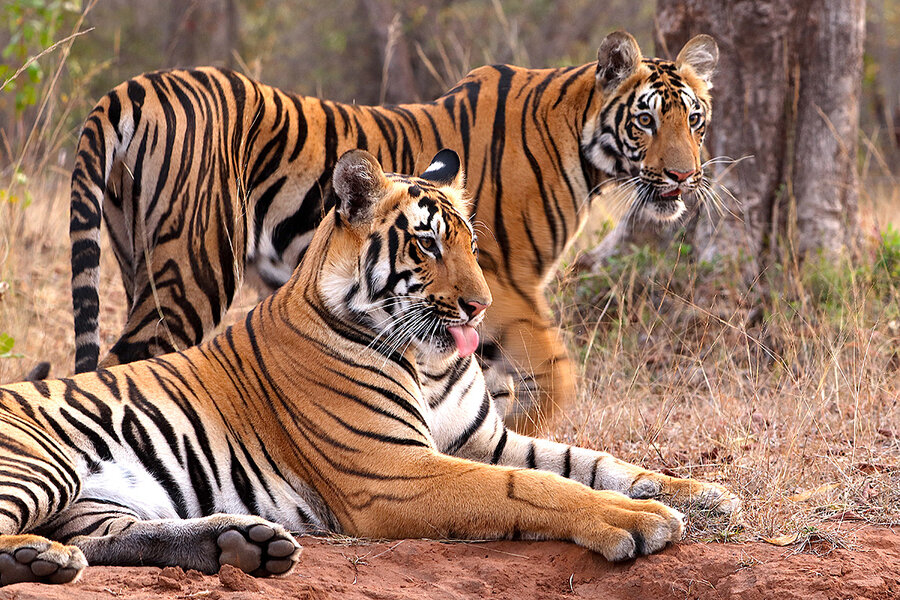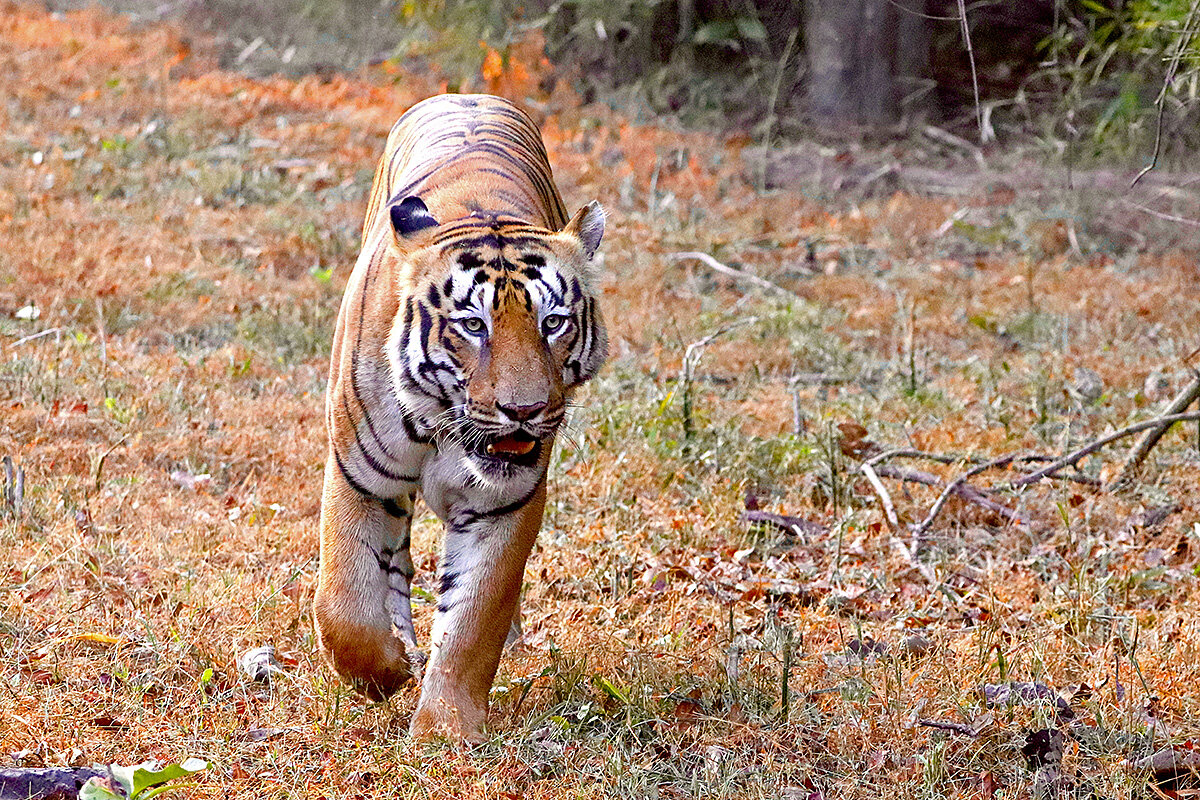As India’s Project Tiger turns 50, hope for the big cat
Loading...
| New Delhi
On a misty winter morning in a central Indian forest, a soft caw-caw punctuates the silence. Dozens of grazing deer perk up their ears, then join in the staccato warning screeches of the langur monkeys and birds high up in the trees. As the chorus of animal alarms reach a crescendo, a frisson of excitement runs through the humans seated on the safari jeeps, bulky cameras and pricey binoculars at the ready. The urgency of these calls can only mean that a predator has been spotted.
The tourists let out a collective gasp when the tiger finally emerges from the thickets, the orange and black fur gleaming in the muted morning sunlight.
You don’t need to go on a wilderness expedition to spot India’s national animal. Several thousand miles away in Los Angeles, at the recent Academy Awards, RRR actor Junior NTR wore a gold tiger motif embroidered on the shoulder of his suit while representing India on the red carpet. And this weekend, the big cat will appear on a commemorative 50 rupee coin.
Why We Wrote This
A story focused onOn the surface, India’s gains on tiger conservation over the past 50 years appear modest, but the momentum growing behind the big cat gives wildlife advocates hope.
Indeed, all eyes are on the king of Indian jungles as the country marks the 50th anniversary of Project Tiger, a program founded in April 1973 to save the species from extinction. Five decades later, India houses the world’s only stable and growing tiger population. Prime Minister Narendra Modi will announce the latest tiger census data at a special event on April 9, with numbers expected to pass 3,000. India also now boasts 53 tiger reserves across 18 states, encompassing about 2.4% of the country’s total land. It’s a success story marked by unwavering hope.
“Back when it started, nobody could have imagined that we would have more than 50 protected tiger reserves in this country,” says conservationist and wildlife tourism expert Amit Sankhala, who is also the grandson of Kailash Sankhala, the first director of Project Tiger. “These habitats exist just for the tiger to exist.”
He believes this is the beginning of a “golden era” for Project Tiger, with expansion of tiger-dedicated spaces, easier access to sustainable wildlife tourism, and increased tiger numbers.
An uphill battle
India’s tiger population dwindled from over 40,000 in the 1930s to a mere 1,827 by the end of the 1960s, due to organized hunting and habitat destruction. Spurred on by the World Wildlife Fund (WWF), the Indian government announced the landmark Wildlife Protection Act in 1972, paving the way for Prime Minister Indira Gandhi to launch Project Tiger the following year. Authorities established nine tiger reserves and implemented a blanket ban on hunting, and the tiger was declared India’s national animal.
Despite the program’s early success, progress has been inconsistent. In fact, tiger numbers dipped to an all-time low of 1,411 in 2008 because of continued habitat loss outside protected areas, as well as unchecked poaching, which wiped out tiger populations in major reserves such as Panna in the central state of Madhya Pradesh and Sariska in the west Indian state of Rajasthan.
That sparked an urgent push to increase public awareness through celebrity campaigns, and the conservation reins were handed over to a special task force known as the National Tiger Conservation Authority. With stricter wildlife policies and improved monitoring, numbers have been rising slowly but steadily since then. Every consecutive four-year census has shown an increase of a few hundred tigers; according to the 2018 census, India has a tiger count of 2,967, a figure which accounts for nearly 75% of all tigers in the wild.
Reputed naturalist and wildlife guru Hashim Tyabji calls India’s success in preventing tigers’ extinction “a miracle in conservation.” The project, he says, is a testament to India’s expertise in capturing and relocating tigers from their home areas to forests where numbers are lower and more space is available for these solitary, territorial animals to roam freely, thus ending localized extinctions (as happened in Panna and Sariska).
“We have started thinking about wilderness and conservation in very novel ways,” he says. “We have modern tools like camera traps to track tigers. And not to forget, there are many many people who are hugely committed to conservation, and practice responsible tourism.”
Indeed, tiger experts say the general population’s growing involvement with wildlife conservation has kept the momentum going.
Hope for India’s wildlife
The uptick in tiger populations is especially impressive considering India’s rapid rate of development, says Aly Rashid, director at Jehan Numa Wilderness, which operates sustainable wildlife lodges in Madhya Pradesh.
“We have 1.4 billion people living here, and the [human] population has doubled since 1973. Given all this pressure on land and resources, I would say this is a huge achievement,” he explains.
Although the WWF reports that wild tiger populations are growing globally, the solitary predator isn’t out of the woods yet. It’s still classified as endangered, and in India, degradation of critical tiger corridors and human-tiger conflict pose serious challenges. But Mr. Rashid is hopeful that with community buy-in, India can overcome these challenges.
“Once people begin to see wildlife as an asset – whether in terms of tourism money or job opportunities for the local community – they will begin to care for it and protect it,” says Mr. Rashid. “And that is what has happened in India.”
That hope extends beyond tigers, which Mr. Sankhala, the conservationist, calls “poster boys for wildlife.” The apex predator has also helped draw attention to India’s other endangered species, he says, including red pandas and Asiatic lions. Recent amendments in the original 1972 wildlife act have made it possible to protect and nurture various animals, from the barasingha (swamp deer) and gaur (Indian bison) in the heart of the country, to the one-horned rhinoceros in the eastern reaches. Some conservation efforts – such as the 1992 Project Elephant and the 2021 Project Dolphin – are modeled directly after Project Tiger.
“Once you save the tiger, you save everything around it,” Mr. Sankhala says. “Suddenly all of nature comes back to life.”







